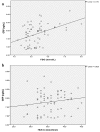Gastrin-Releasing Peptide and Glucose Metabolism Following Pancreatitis
- PMID: 28912908
- PMCID: PMC5593441
- DOI: 10.14740/gr890w
Gastrin-Releasing Peptide and Glucose Metabolism Following Pancreatitis
Abstract
Background: Gastrin-releasing peptide (GRP) is a pluripotent peptide that has been implicated in both gastrointestinal inflammatory states and classical chronic metabolic diseases such as diabetes. Abnormal glucose metabolism (AGM) after pancreatitis, an exemplar inflammatory disease involving the gastrointestinal tract, is associated with persistent low-grade inflammation and altered secretion of pancreatic and gut hormones as well as cytokines. While GRP is involved in secretion of many of them, it is not known whether GRP has a role in AGM. Therefore, we aimed to investigate the association between GRP and AGM following pancreatitis.
Methods: Fasting blood samples were collected to measure GRP, blood glucose, insulin, amylin, glucagon, pancreatic polypeptide (PP), somatostatin, cholecystokinin, gastric-inhibitory peptide (GIP), gastrin, ghrelin, glicentin, glucagon-like peptide-1 and 2, oxyntomodulin, peptide YY (PYY), secretin, vasoactive intestinal peptide, tumor necrosis factor-α (TNF-α), monocyte chemoattractant protein (MCP)-1, and interleukin-6. Modified Poisson regression analysis and linear regression analyses were conducted. Four statistical models were used to adjust for demographic, metabolic, and pancreatitis-related risk factors.
Results: A total of 83 individuals after an episode of pancreatitis were recruited. GRP was significantly associated with AGM, consistently in all four models (P -trend < 0.05), and fasting blood glucose contributed 17% to the variance of GRP. Further, GRP was significantly associated with glucagon (P < 0.003), MCP-1 (P < 0.025), and TNF-α (P < 0.025) - consistently in all four models. GRP was also significantly associated with PP and PYY in three models (P < 0.030 for both), and with GIP and glicentin in one model (P = 0.001 and 0.024, respectively). Associations between GRP and other pancreatic and gut hormones were not significant.
Conclusion: GRP is significantly increased in patients with AGM after pancreatitis and is associated with increased levels of pro-inflammatory cytokines, as well as certain pancreatic and gut hormones. Detailed mechanistic studies are now warranted to investigate the exact role of GRP in derangements of glucose homeostasis following pancreatitis.
Keywords: Cytokines; Gastrin-releasing peptide; Gut hormones; Pancreatic hormones; Post-pancreatitis diabetes mellitus.
Conflict of interest statement
None.
Figures


Similar articles
-
Pro-inflammatory cytokines after an episode of acute pancreatitis: associations with fasting gut hormone profile.Inflamm Res. 2018 Apr;67(4):339-350. doi: 10.1007/s00011-017-1125-4. Epub 2017 Dec 29. Inflamm Res. 2018. PMID: 29288273
-
Calcitonin gene-related peptide: neuroendocrine communication between the pancreas, gut, and brain in regulation of blood glucose.Ann Transl Med. 2017 Nov;5(21):419. doi: 10.21037/atm.2017.08.27. Ann Transl Med. 2017. PMID: 29201871 Free PMC article.
-
Cross-talk between innate cytokines and the pancreatic polypeptide family in acute pancreatitis.Cytokine. 2017 Feb;90:161-168. doi: 10.1016/j.cyto.2016.11.014. Epub 2016 Dec 3. Cytokine. 2017. PMID: 27918953 Clinical Trial.
-
The effect of bariatric surgery on gastrointestinal and pancreatic peptide hormones.Peptides. 2016 Mar;77:28-37. doi: 10.1016/j.peptides.2015.08.013. Epub 2015 Sep 5. Peptides. 2016. PMID: 26344355 Review.
-
Cholecystokinin in the control of gastric acid and plasma gastrin and somatostatin secretion in healthy subjects and duodenal ulcer patients before and after eradication of Helicobacter pylori.J Physiol Pharmacol. 1994 Dec;45(4 Suppl 1):3-66. J Physiol Pharmacol. 1994. PMID: 7787215 Review.
Cited by
-
Neurotransmitters regulate β cells insulin secretion: A neglected factor.World J Clin Cases. 2023 Oct 6;11(28):6670-6679. doi: 10.12998/wjcc.v11.i28.6670. World J Clin Cases. 2023. PMID: 37901031 Free PMC article. Review.
-
Identification of novel differentially expressed genes in type 1 diabetes mellitus complications using transcriptomic profiling of UAE patients: a multicenter study.Sci Rep. 2022 Sep 29;12(1):16316. doi: 10.1038/s41598-022-18997-w. Sci Rep. 2022. PMID: 36175575 Free PMC article.
-
Oxyntomodulin May Distinguish New-Onset Diabetes After Acute Pancreatitis From Type 2 Diabetes.Clin Transl Gastroenterol. 2020 Feb;11(2):e00132. doi: 10.14309/ctg.0000000000000132. Clin Transl Gastroenterol. 2020. PMID: 32463621 Free PMC article.
-
Antidiabetic Medications and Mortality Risk in Individuals With Pancreatic Cancer-Related Diabetes and Postpancreatitis Diabetes: A Nationwide Cohort Study.Diabetes Care. 2019 Sep;42(9):1675-1683. doi: 10.2337/dc19-0145. Epub 2019 Jun 21. Diabetes Care. 2019. PMID: 31227582 Free PMC article.
-
The circadian rhythm: an influential soundtrack in the diabetes story.Front Endocrinol (Lausanne). 2023 Jun 27;14:1156757. doi: 10.3389/fendo.2023.1156757. eCollection 2023. Front Endocrinol (Lausanne). 2023. PMID: 37441501 Free PMC article. Review.
References
-
- Uche-Nwachi E, Mitchell C. Effect of alloxan-diabetes on gastrin-releasing peptide (grp) immunoreactivity in the gastrointestinal tract, of sprague dawley rats and how this may affect some of the diabetic complications. OJBS. 2007;7:3–7. doi: 10.3844/ojbsci.2007.3.7. - DOI
Grants and funding
LinkOut - more resources
Full Text Sources
Other Literature Sources
Miscellaneous
